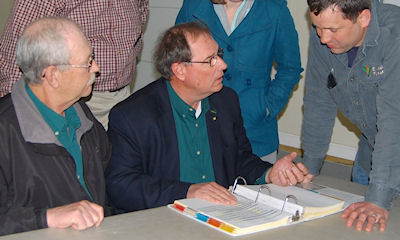
After years of contentious wrangling and fine-tuning, Maryland's Phosphorus Management Tool went into effect June 8. It may well portend the future for farmers in other states in the Chesapeake Bay, Great Lakes and Mississippi River watershed.

HOW MUCH RECORDKEEPING?! Even before Maryland's new P Management Tool became law, required nutrient management plans such as the book on this table began mandatorily squeezing down P levels on Maryland and Delaware farms. Illinois farmers (pictured) found the details mind-boggling.
So there's no misunderstanding, this tool is for regulatory use in tightening down phosphorus use on farmland. "The PMT reflects our best understanding, based on a national body of science, of how phosphorus moves from farm fields into our rivers and streams," says Maryland Governor Larry Hogan. "Maryland farmers have always embraced science-based policy, and these regulations further demonstrate how committed Maryland farmers are to restoring our treasured Chesapeake Bay."
The Chesapeake Bay regulatory arena has long been a battleground of political science versus sound science, according to one policy insider. And "political science won the battle by intimidation."
What's in the P toolbox
In brief, the PMT regulations establishes phosphorus as the key limiting factor in nutrient management and application plans. It forces an immediate ban of additional P on fields with a soil Fertility Index Value of 500 or greater. Those are fields at highest risk of P potentially entering nearby waterways.
Beginning in 2016 and every six years thereafter, soil test P data will be collected for all farms in Maryland subject to nutrient management plan requirements. That includes most farms. The data will give MDA enough accurate soil fertility data to monitor P level trends and identify potential areas for redistributing newly available manure.
Farms with high FIV scores using animal or poultry manures as organic P and nitrogen sources will be required to use inorganic commercial N instead. And, those manures will have to be transported to other farms meeting the PMT requirements. Statewide farm PMT data will be instrumental in identifying potential receiving areas and in developing alternative uses.
Farms with excess soil P will be placed in three tiers based on the farm's average P fertility index value. Those scoring 450 and greater will be the first required to immediately begin implementing the PMT. Those scoring 300 and greater, but less than 450 will be required to start later, but have less time to transition. The same holds for those scoring 150 or greater, but less than 300.
~~~PAGE_BREAK_HERE~~~
* Nutrient management plans must be filed with MDA for operations with P FIV's of 150 and above.
* MDA must protect the identity of the person for whom the plan was prepared and that person's personal information. State law limits that protection to three years, according to industry sources.
* Soil P test levels must be expressed in terms of FIV for each field or management unit.
* Those reports must be filed with MDA no later than September 30 and every sixth year thereafter.
* The law also has nutrient management plan rules for container or out-of-ground ag production.
Then there's the $22.5 million ag cost
Most stunning is that the PMT would cost the ag industry $22.5 million – after subsidies are accounted for, according to the economic impact study done by the Business Economic and Community Network at Salisbury University.
This information comes directly from the PMT report posted on the Maryland Register. Keep in mind that Maryland is a relatively small farm state.
Also keep in mind that the report assumes a six-year phase-in scenario, with $79 million in incentives and program support to offset farm-related costs and support the deployment of alternative technologies related to manure utilization. Current state and federal funding provide $58 million of support. Another $21 million is assumed to be new funding, with $15.5 million of that new funding provided from state sources.
Assuming 228,000 tons of additional poultry litter would require relocation to other farms for land Application, that cost is pegged at $14 per ton for transportation costs. It exceeds the state's Manure
Transport Program funding by $4.6 million. The Maryland Register report also acknowledged that the current year's fiscal budget did not contain sufficient funds to implement the regulations.
However, the Salisbury University study did note positive economic benefits of $10.1 million for other industries or trade groups and direct/indirect public effects of $100 million. Those values for environmental and social benefits were attributed to a 2014 report by the Chesapeake Bay Foundation.
For more PMT details, visit www.mda.maryland.gov/PMT.
About the Author(s)
You May Also Like




